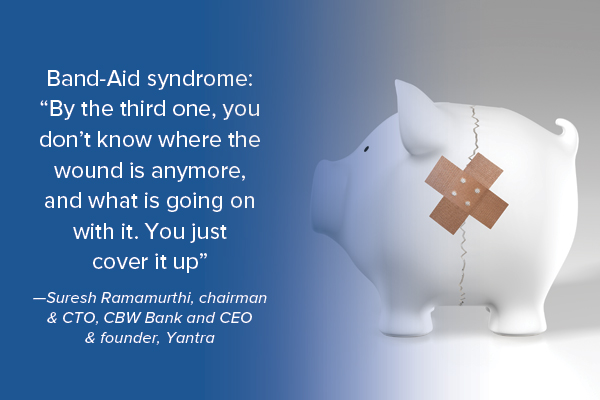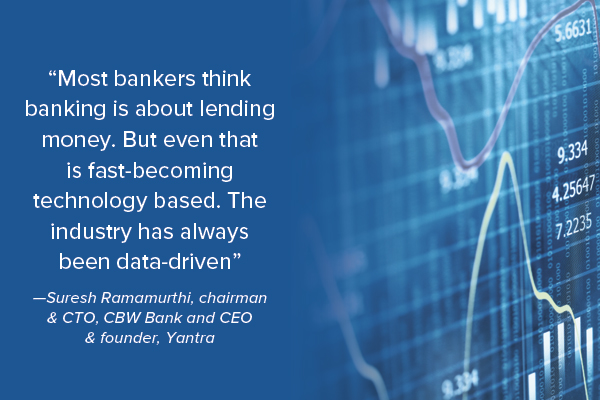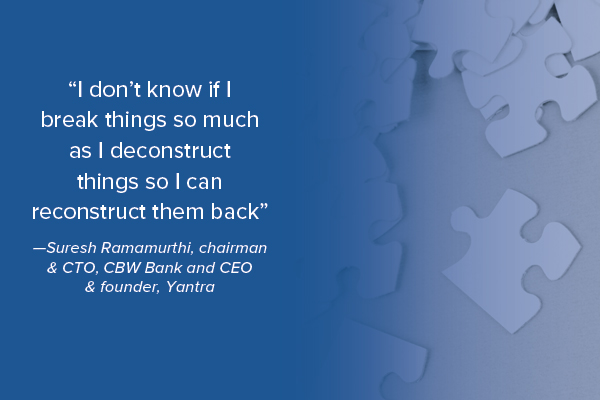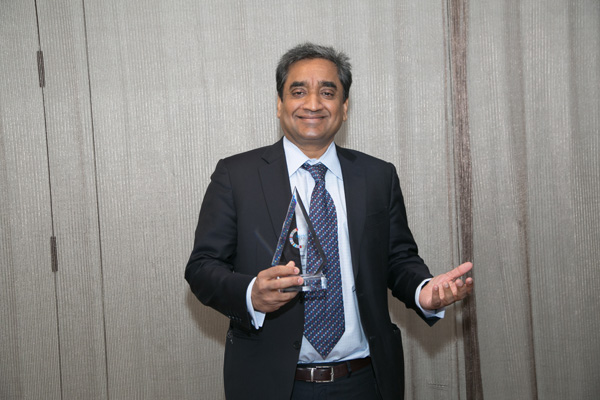Time to fix banking's plumbing
Banking must stop adding Band-Aids, says banker-fintech exec Suresh Ramamurthi
- |
- Written by Steve Cocheo
 When your bank innovates, is “slapping an app” on top of old tech the best it can do? Suresh Ramamurthi of CBW Bank and Yantra says the problem is that bankers can’t fix the industry’s “plumbing,” the legacy internal systems and the legacy payment systems.
When your bank innovates, is “slapping an app” on top of old tech the best it can do? Suresh Ramamurthi of CBW Bank and Yantra says the problem is that bankers can’t fix the industry’s “plumbing,” the legacy internal systems and the legacy payment systems.
When the subject of innovation comes up, Suresh Ramamurthi recalls how a few years ago, one of the major U.S. automakers ran a commercial showing two truck owners comparing their vehicles. “Well, my truck has WiFi. Does yours?” one owner declares.
“My question was, ‘Have you not heard of having a WiFi hot spot on your phone? Everybody has one!’” says Ramamurthi.
Meanwhile, Ramamurthi says in 2015, electric car manufacturer Tesla introduced, with considerably less fanfare, an update of its app that included the first version of its “Summon” feature. This feature allowed the user, on private property, to have a Tesla vehicle open the garage, park itself, and shut off—all remotely and automatically. And the app allowed Summon to have the car pick up the owner as well, like a Labrador Retriever.
“Which do you think is the better example of innovation?” asks Ramamurthi. “The traditional automakers had a legacy chassis that their designers couldn’t touch, so they came up with the idea of plugging in a third-party, WiFi hot spot in the roof of a truck and called it innovation. Meanwhile, Tesla rethought the entire vehicle, including the chassis. Completely new electronics and software enable control of the car in so many ways. Software that can now tell the car which way to turn the wheel, which way to go, and how fast.”
Too often, Ramamurthi believes, in banking, institutions are “slapping a mobile app on top of some bank account and they claim they’ve done innovation.”
They do that, he explains, because in so many ways, they can’t fix the industry’s “plumbing,” the legacy internal systems and the legacy payment systems that underlie so much of what is flowing through banking institutions.
Banking suffers, says Ramamurthi, from what he calls “the third Band-Aid problem.” A problem begins with a cut, figuratively. The bank applies a temporary solution, as a “Band-Aid.” And then another. And another.
“By the third one, you don’t know where the wound is anymore and what is going on with it. You just cover it up. Big banks have a guy who is a ‘vice-president in charge of the third Band-Aid,’ and he comes to believe that that third Band-Aid is integral to the survival of the bank.”

By now, you’ve likely gathered that Suresh Ramamurthi is not one to pull punches or to be diplomatic when he’s confronted with an assumption quoted as fact that needs challenging.
Where are things really at?
Ramamurthi, a former Google engineer, is chairman and chief technology officer of CBW Bank, Weir, Kan., and founder and CEO of Yantra Financial Technologies, which specializes in bank-oriented software and apps. The $31-million assets bank is the platform underpinning the Moven app in the U.S. and is expanding the scope of services it offers to other banks.
Unlike so many fintech names, the word yantra is a real word in Sanskrit. It literally translates as “machine” or “contraption,” but also refers to diagrams used in meditation and worship.
Ramamurthi and his wife, Suchitra Padmanabhan, the bank’s president, acquired the troubled one-branch, family-owned CBW Bank in 2009. The bank continues to serve the small Weir community (population 663), although it does little lending now.
Yantra was launched when Ramamurthi found that the bank’s original technology vendor would not even discuss APIs (application program interfaces). Even after switching core system vendors, Ramamurthi wasn’t getting the tools he believes banks need, so Yantra came into being.
Too many bankers—and too many traditional bank technology companies’ executives, in his view—lack a good understanding of how banking has evolved. “Many can’t really talk technology,” says Ramamurthi, “and banking is now a technology business.”
Does he think other bankers know that?
“I don’t know,” Ramamurthi says. “Some do, some don’t, and some don’t care. That’s because most bankers I’ve met think banking is about lending money. But even that is fast-becoming technology based. The industry has always been data driven. For a long time, the data was in bankers’ heads. Now, it’s done with computers.”

One way or another, lending hinges on knowing the gap between a customer’s receiving and spending—the difference is the need for credit, he suggests.
In Ramamurthi’s view, community bankers who don’t have in mind to sell out and leave the battle to others have a limited amount of time to change their approach to innovation and technology.
“At some point, somebody is going to bring a gun to the bow-and-arrow fight,” Ramamurthi says. “And when that happens, you are done. So once the gun becomes available, why would you keep on making bows and arrows?”
While mainstream core processing vendors would surely dispute this, Ramamurthi believes they are in much the same place as traditional automakers who add WiFi because they can’t do much about vehicle basics.
“The competencies acquired to run the core vendors may not be the same ones necessary to transform them, especially if the core vendors are depending on their bank customers to give them feedback on how to transform the core systems and to transform the banks,” says Ramamurthi.
“The kind of people you need to hire to build the next iteration of bank technology are different from those at the core vendors now,” he continues. “Those companies operate in a very industrialized way for building things. They will say, ‘We are heavy duty, and we have all this blah, blah, blah.’ But in reality, two guys and a dog in Silicon Valley can build something better.”
Ramamurthi holds up Twitter as an example of something that originated with a minimal team, but today handles over 600 million tweets daily.
So where does Ramamurthi find all his people?
“Ah, that’s a closely guarded secret,” he jokes. “But we try to have people who are not in banking, who have advanced degrees in other areas, and very good critical thinking.”
The future will not necessarily belong to the innovator or to the smart incumbent player, but to players who can evolve and improvise, in Ramamurthi’s view.
Amazon began as an online bookseller and quickly overtook the internet operations of Barnes & Noble and Borders. The first still survives, while the second went out of business long ago. But Ramamurthi finds what happened next much more instructive.
“Amazon thought, ‘A book is just a SKU number, right? So anything with a SKU is something we can sell,’ and that is how Amazon became a multi hundred-billion dollar sales machine,” says Ramamurthi. As soon as any industry’s “Amazon” can scale up to drive its costs way down, it “pretty much puts the next guy who’s got a higher cost base out of business.”
In fact, Ramamurthi believes it is the Bank Holding Company Act that has kept traditional banks in business. That law requires owners of a bank that own other types of companies to put everything under federal, financial regulatory scrutiny. Absent that factor, he says, the likes of Amazon and Google would have become banks already.
“And they have better technology than any bank in the world,” he says.
Banking life after Google
Thus far, Ramamurthi is not overly attracted by the idea of the national fintech charter. He says that there are unanswered questions, even after the OCC released its chartering manual draft in March.
“I prefer to be a real bank,” he adds, because that gives CBW the full range of powers available to a chartered institution with deposit insurance.
Still, he recognizes the limitations there. For many years, banks spoke of the payments system as theirs—something they operated and something they controlled. Ramamurthi scoffs. “They don’t have the rails,” he says. “Access to the rails was given to them by the government or by third parties like Mastercard and Visa. What rails do individual banks have? They have a charter.”
Founding Yantra in parallel with CBW has ushered in a steady stream of innovation shared with the bank and other client banks. CBW was named Celent Model Bank of the year for corporate payments in 2016.
One example of innovation is the OneCard, a Mastercard giving the user the option to use it to send funds anywhere from instantly to a few days, depending on the option selected and the fee the user is willing to pay. (The funds can be transferred from one OneCard member to another at no charge.)
Along the way, CBW and Yantra have created solutions, such as cards designed to work in only certain locations—like corporate gas cards usable only where a company enjoys fleet pricing, and online account opening that can perform know-your-customer functions and everything else in less than a minute. Of the latter, Ramamurthi resists the label “regtech.”
“Regtech assumes a separate thing that you can plug into,” he explains. “I don’t think that that will work anymore. You have to build everything into a single, holistic platform.” Once he discovered how much of the fabric of banking compliance is, he trained and became certified in the “art.” Beyond compliance, he believes, anti-fraud and risk management features must be baked in, too.
Old rails and old plumbing
OneCard and other innovations developed by Ramamurthi’s organizations ride on the existing payment rails, which frustrates him.
“I have to use the existing rails, and I’m using them to their full potential,” he says, but they are a mishmash of stitched-together systems, protocols, and linkages that don’t function especially efficiently. “The entire set of payments channels are very old—some of them 20 years old, some 40 years old, some even 100 years old. They all settle differently, and they all use different ways to address the same bank account.”
He acknowledges that efforts to bring about fast payments are underway. The Federal Reserve promises a paper full of recommendations in mid-2017. But, no pun intended, Ramamurthi doesn’t feel these have come along fast enough.
One author, John Waupsh in 2016’s Bankruption, said of Ramamurthi that “he breaks things to fix them his way.”
“I don’t know if I break things,” explains the banker-fintech executive, in reaction, “so much as I deconstruct things so I can reconstruct them back. I mean, if you took over a dilapidated old building, you really couldn’t fix it until you fixed the plumbing.”

Interestingly, an affiliated Yantra website, Y Labs Marketplace, uses a plumbing motif and invites visitors to “Say hello to our plumbing.” Among other features, nearly two dozen Yantra APIs are listed.
Blockchain overhyped
At some point, the U.S. financial system will find that circumstances demand ripping out the old plumbing and renovating things, Ramamurthi believes. As extreme as that may seem, he says, a shift on a significant scale has begun in his native India. It’s called “Cashless India,” a subset of the massive “Digital India” program, which launched in 2015. The parent program included creation of digital identities for all Indians based on fingerprints and retina scans.
One aspect that’s already been implemented is the ability to send money to anyone else in India at no charge, electronically and instantaneously.
“They did it for 500 million accounts,” says Ramamurthi. “And once they built out the framework, it took a start-up only three weeks to build the app and a month to roll it out.”
As exciting as such change is, something that doesn’t get Ramamurthi excited is all the talk of the potential of blockchain technology. For one thing, he is very skeptical of many who speak of it. There is more of “cool” here, he thinks, than “real.”
“It’s like listening to two kindergartners who are talking about something they don’t know about, but they love the sound of the word,” maintains Ramamurthi.
In terms of banking functionality, Ramamurthi doesn’t see it. While he would like to see today’s aged rails replaced, blockchain won’t do it.
“This was designed for a specialty purpose—decentralized banking,” Ramamurthi explains. “And I don’t see decentralized banking happening any time soon.”
That said, there are elements of the technology that do appeal to Ramamurthi, and he says he and his developers have deconstructed blockchain technology to extract those useful functions for their own suite of products.
Where he wants to go
Ultimately, Ramamurthi says what he is after is the creation of a smart banking account that offers, in a painless, frictionless way, a central role for one’s bank in one’s life.
“In time, as a consumer, I will expect that my bank will know that my AT&T bill is higher or lower than normal, and that it will then ask me for a ‘yes or no’ regarding paying it,” says Ramamurthi.
In early April CBW Bank was the winner of the Celent Model Bank 2017 award for Banking as a Platform. Above, Chairman and Chief Technology Officer Suresh Ramamurthi with the award.
Asked if he thought Americans are truly ready for such a gear shift in how they interact with their banks, Ramamurthi bridled at the question. “No, it is not a gear shift,” he insists. “This is what a person’s bank used to do. It used to help citizens of a given village or town or city to conduct commerce. I call this kind of service ‘commerce enablement’.”
What would need to change is bank thinking, he admits. Cross selling? That would disappear as traditionally thought about. Any selling of additional services would occur in the moment as a need suggests a way that the bank can fulfill it—all in real time, adds Ramamurthi.
Amazon’s Echo digital hub and its Dash buttons, permitting easy, timely ordering of commonly used goods, are already introducing this concept.
“Banks haven’t done the same thing yet,” says Ramamurthi. “We are working towards that.”
At times, the bank service would be in the position of telling the customers to rein in their spending. Would that be counseling or advice?
“No,” says Ramamurthi. “The bank is providing you with data, information in real time. You decide what you want to do with it.”
Tagged under Technology, CSuite, People, Community Banking, Fintech,
Related items
- Wall Street Looks at Big Bank Earnings, but Regional Banks Tell the Story
- How Banks Can Unlock Their Full Potential
- Banking Exchange Interview: Soups Ranjan Founder and CEO of Sardine Discusses AI
- Digital Wallets Account for Half of Online Sales
- One in Five Oppose Fed’s Proposed Changes to Regulation II














